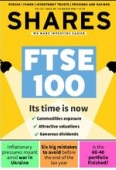Archived article
Please note that tax, investment, pension and ISA rules can change and the information and any views contained in this article may now be inaccurate.
FTSE 100: Its time is now

After years in the wilderness the FTSE 100 is finally coming into its own as some of the key features of the index go from being liabilities to advantages.
Our analysis suggests that, in a world of inflation, rising interest rates and surging commodity prices, many of the big names which dominate the index are well placed. As well as domestic investors, this could well increase the appeal of the UK’s largest stocks to overseas investors.
In this article we will examine the FTSE 100 in some detail and discuss the most cost-effective and efficient ways of gaining exposure to its returns.
The relative resilience of the FTSE 100 to the current difficult market conditions is reflected in its year-to-date performance where it has comfortably outshone its global counterparts.
The index has only dipped 5% in 2022 whereas the US S&P 500 benchmark is down 12%, the CAC 40 in Paris is down 16% and Germany’s DAX and the US technology-focused Nasdaq index are down around 18%.
This is a direct reversal of the situation in the preceding decade where the FTSE 100 had struggled and lagged other markets in the developed world. There were several factors behind this situation, a key one being political instability.
FTSE 100 KEY ATTRIBUTES
Generous dividends
Attractive valuations
Significant commodities exposure
Arguably since early 2012 when the UK Government agreed to a referendum on Scottish independence and certainly since 2015 when the path was set for the Brexit referendum, investors in the UK have had to contend with significant uncertainty over the constitutional direction of the country and its politics.
And just when the decisive victory for the Conservative Party in the 2019 General Election and a subsequent UK-EU Brexit deal seemed to herald a period of stability, the pandemic and the Government’s response to it helped upset the apple cart.
The FTSE 100 also suffered from a perception, based at least in part on reality, that it was very much an ‘old world’ index, under-represented in technology.
As tech valuations surged, a trend accelerated by the pandemic as – by necessity – a lot of activities moved online, the UK’s flagship index was left for dust.
Today the situation is different. The current surge in inflation, initially linked to pent-up demand from the pandemic, has changed things. As central banks scramble to respond by hiking interest rates, with the Ukrainian conflict only adding to inflationary pressures, companies with limited or no cash flow today but offering the potential for lots of cash flow in the future are much less attractive to investors.
In contrast there are lots of more attractively valued FTSE 100 names generating plenty of cash and, in many cases, paying generous dividends too. These are the types of businesses which many investors now favour.
Exposure to Russia and Ukraine
The FTSE 100 does have some exposure to Russia and Ukraine but it is relatively limited. Two of its largest companies – BP (BP.) and Shell (SHEL) – had very material Russian interests, though both are now taking steps to extricate themselves. Additionally Russian gold miner Polymetal (POLY) and steel producer Evraz (EVR) both dropped out of the index during the most recent reshuffle. This reflects the massive slump in their share prices since Russia’s invasion of Ukraine.
THE TOP 20
Let’s look at the top 20 stocks by market value in the FTSE 100. Five are in the resources sector, including Shell (SHEL), the largest name in the index. If you count London Stock Exchange (LSEG), a further five are financials – three of which are banks which all pay generous dividends.
Five stocks are in traditionally defensive sectors like telecoms, utilities, tobacco and healthcare which tend to be less impacted by fluctuations in economic growth.
Even in a downturn people still must eat, which means catering giant Compass (CPG) also has some defensiveness built in.
Of the remainder, big brand consumer goods firms Reckitt (RKT) and Unilever (ULVR) are out of favour as they face rising input costs and pressures on spending implied by a cost-of-living crisis, while alcoholic drinks firm Diageo (DGE) and RELX (REL) sit in the category of quality stocks.
It is worth noting demand for alcohol tends to hold up well in good and bad economic conditions including recession, and Diageo is focused on the spirits market where brands tend to hold sway with drinkers, more so than in other categories like beer and wine.
More than half of the FTSE 100’s top 20 have seen share price gains year-to-date, with the miners and oil and gas firms chalking up an impressive performance. These companies are arguably well placed in an inflationary environment, with commodity prices surging higher.
COMMODITIES STRENGTH
Under-investment in new mines and oil and gas fields in recent years means there is limited supply, while demand for oil and gas is proving durable despite an apparent global commitment to move away from fossil fuels.
Investment to shift towards renewables for power generation and away from combustion engines to electric vehicles will require lots of metals and minerals, providing long-term demand drivers for the mining sector.
It’s not all good news. Banks have been disappointing shares to own for much of the time since the global financial crisis in 2008, and more recently the war in Ukraine has seen expectations for interest rate rises dialled back.
It was hoped higher interest rates would improve banks’ profitability, allowing them to charge more for customer loans. Slower than anticipated rate hikes could see earnings forecasts trimmed by analysts. Though to what extent central banks can afford to take their foot off the gas on rates is open to question given the level of inflationary pressures we are currently seeing.
There is also a risk that the cost-of-living crisis and more expensive debt results in more impairments as businesses and individuals struggle to keep on top of their borrowings.
HSBC (HSBA), which despite its UK presence is much more of an Asian business. The bank is the outlier year-to-date as it has delivered a robust share price performance whereas Lloyds (LLOY) and Barclays (BARC) are nursing share price losses.
ATTRACTIVE VALUATIONS AND GENEROUS INCOME
A common thread running through most of the FTSE 100’s largest names are their attractive valuations and generous yields, even for those which have enjoyed decent runs of late.
The average (not weighted by market cap) forecast price to earnings ratio and dividend yield for the top 20 FTSE 100 stocks is 13.4 times and 4.3% respectively. If you focus just on the top 10 it is 11.3 times and 5%.
As a point of comparison, the top 10 US-listed shares by market cap have an average forward PE of 33 times according to SharePad and more than half don’t even pay a dividend. For those which do the average yield is a mere 1%.
How to get exposure to the FTSE 100
The lowest cost, and most straightforward way to get exposure is through an ETF (exchange-traded fund) which tracks the performance of the index.
The largest and most well-established ETF product tracking the FTSE 100 index is iShares Core FTSE 100 (ISF) which has ongoing charges of 0.07% and distributes income on a quarterly basis. There is also version which reinvests income – iShares Core FTSE 100 (CUKX) – and this carries the same charges.
Important information:
These articles are provided by Shares magazine which is published by AJ Bell Media, a part of AJ Bell. Shares is not written by AJ Bell.
Shares is provided for your general information and use and is not a personal recommendation to invest. It is not intended to be relied upon by you in making or not making any investment decisions. The investments referred to in these articles will not be suitable for all investors. If in doubt please seek appropriate independent financial advice.
Investors acting on the information in these articles do so at their own risk and AJ Bell Media and its staff do not accept liability for losses suffered by investors as a result of their investment decisions.

 magazine
magazine












